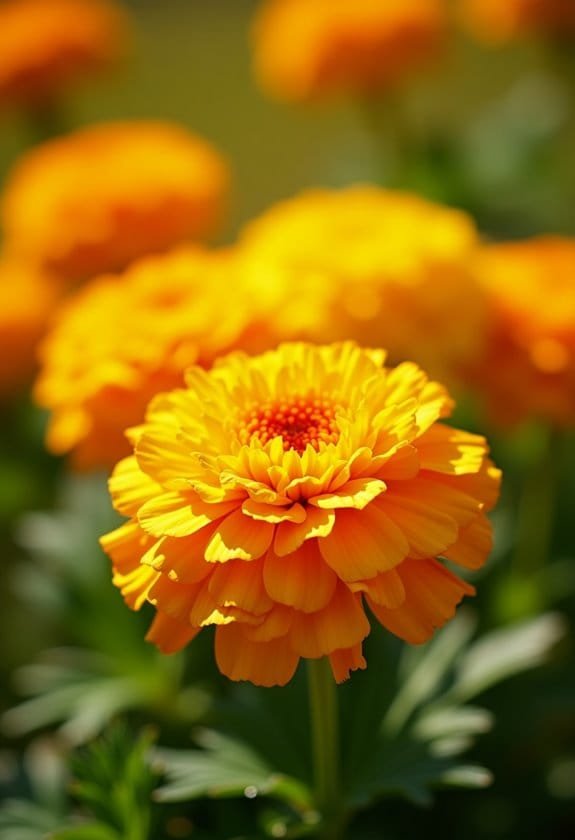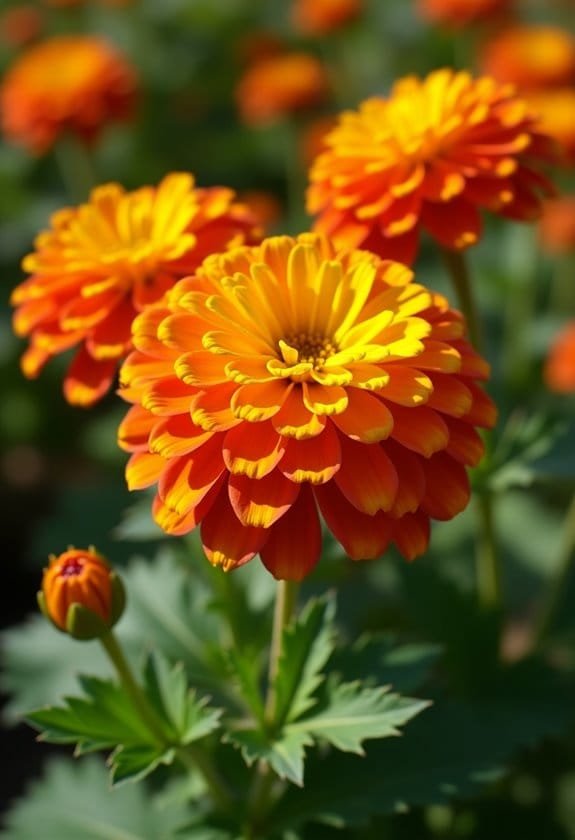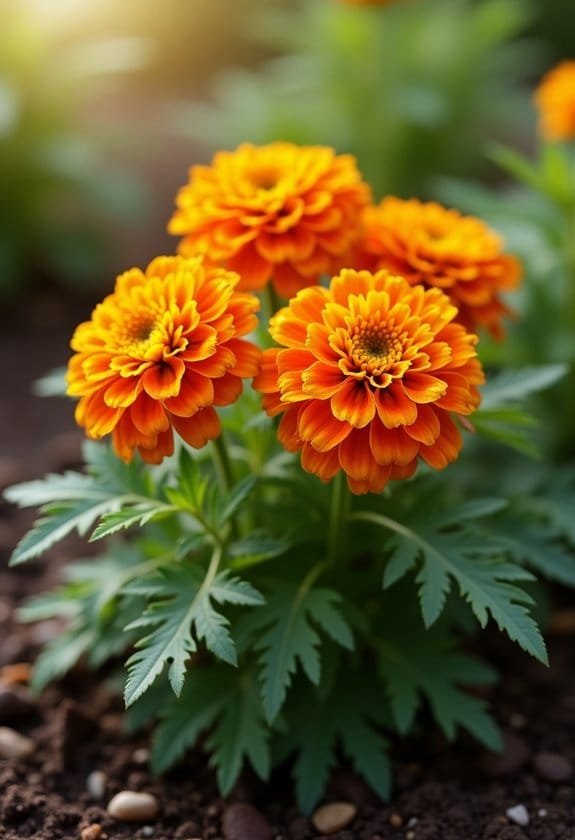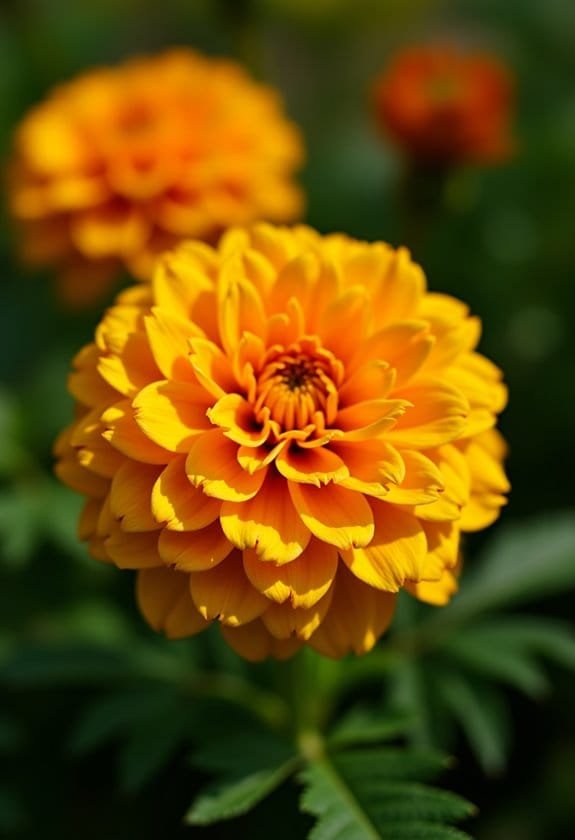Tagetes patula, known as French Marigold, is a resilient flowering plant that typically grows between 6 to 12 inches high. With its vibrant hues of red, orange, and yellow, it thrives in full sun and well-drained soils, favoring pH levels between 6.0 and 7.0. This plant is not only visually striking but also promotes ecological health by attracting beneficial insects like bees and butterflies. Regular deadheading encourages continuous blooms from early summer until frost, while careful management helps prevent common issues, such as root rot and pest infestations. There's much more to explore about this fascinating plant's horticultural benefits.
Main Points
- French Marigold, or Tagetes patula, thrives in full sun and well-drained soil, with optimal growth around 70°F.
- This compact plant reaches heights of 6 to 12 inches and displays vibrant flowers in red, orange, and yellow.
- Regular deadheading encourages continuous blooming, while ample initial watering establishes strong roots.
- French Marigolds attract beneficial insects, offering ecological benefits as natural pest deterrents and enhancing garden biodiversity.
- Susceptible to spider mites and powdery mildew, monitoring and maintaining good air circulation are essential for healthy plants.
Introduction

Tagetes patula, widely known as French Marigold, captivates gardeners with its vivid color palette and compact size, typically reaching heights and widths of 6 to 12 inches.
Native to the warm climates of Mexico and Guatemala, this resilient annual thrives effortlessly in full sun and well-drained soil, making it a favorite for both novice and experienced horticulturists.
With its fragrant blooms and ability to attract beneficial insects while repelling pests, French Marigold not only enhances aesthetic appeal in gardens but also plays a significant role in sustainable gardening practices.
Common Name
Known widely as French Marigold, Tagetes patula brings a splash of color and vibrancy to gardens around the world. The common name, reflecting its French origins, captures the essence of this beloved plant, renowned for its vibrant flowers in shades of reds, oranges, and yellows.
Garden enthusiasts appreciate these flowers not only for their stunning aesthetics but also for their adaptability and robustness. French Marigolds thrive in full sun, requiring minimal care while exhibiting impressive performance across various soil conditions. This adaptability makes them suitable for diverse climates, allowing them to flourish in many regions.
Growing between 6 to 12 inches tall, they serve as charming additions to beds, containers, and garden edges, effectively enhancing the visual appeal of any landscape design. Notably, French Marigolds are characterized by low toxicity, ensuring safety around children and pets—a significant factor for families looking to beautify their outdoor spaces without concern. Additionally, like their relative Calendula officinalis, they attract beneficial insects, contributing to natural pest management within garden environments.
Ultimately, French Marigolds represent a delightful fusion of beauty, versatility, and practicality, inviting gardeners of all levels to appreciate the joy these vibrant flowers bring to their environments.
Scientific Name
In botanical classification, the scientific name Tagetes patula serves as an essential identifier for French Marigold. This nomenclature is significant, as it distinguishes this vibrant flower within the broader Asteraceae family, known for its diverse flowering plants. The term "Tagetes" signifies the genus, while "patula," derived from Latin, translates to "with a spreading habit," aptly describing the plant's growth form.
Native to regions of Mexico and Guatemala, Tagetes patula flourishes in warm climates, particularly in well-drained soils, where it often reaches heights of 6-12 inches (15-30 cm). This compact structure contrasts beautifully with the bold hues of its blossoms, which bloom in spectacular shades of red, orange, and yellow, creating a vivid display in any garden setting.
Additionally, the flowers emit a rich, spicy fragrance, enhancing their allure not only for aesthetic purposes but also as a natural insect deterrent.
Understanding the scientific designation of French marigolds like Tagetes patula enriches appreciation for their ecological roles and cultivation practices. This knowledge empowers gardeners to optimize their growing conditions and celebrate the plant's unique characteristics.
Overview
French Marigold captivates gardeners with its vibrant colors and resilience, making it a favorite in many landscapes. Scientifically known as Tagetes patula, this compact annual typically reaches heights and widths of 6-12 inches, showcasing a stunning array of flowers in shades of red, orange, and yellow. Blooming from early summer until frost, the flowers add delightful splashes of color to any garden.
Known for its spicy fragrance, the foliage provides effective insect deterrence, rendering the French Marigold invaluable for natural pest control. This adaptable plant thrives in full sun and well-drained soils, demonstrating remarkable tolerance to varying conditions such as heat, humidity, and drought, which makes it suitable for diverse garden designs.
Characteristically low-maintenance, Tagetes patula can flourish in hardiness zones 2 to 11. Regular deadheading encourages continuous blooming, ensuring that the stunning flowers keep brightening landscapes throughout the season.
Originating from the rich soils of Mexico and Guatemala, these marigolds can easily be propagated by sowing seeds post-frost or starting them indoors 6-8 weeks before the last frost, making them an accessible choice for gardeners keen to enhance their spaces.
Key Features
Tagetes patula, or French Marigold, typically grows between 6 and 12 inches both tall and wide, showcasing a variety of semi-double, double, and crested flowers that can measure up to 2 inches in diameter.
From early summer until frost, this resilient annual bursts forth with vibrant blooms in fiery shades of red, orange, and yellow, creating a colorful spectacle that brightens any garden space.
Its adaptability to full sun and well-drained soils, coupled with an ability to endure slightly harsh conditions, makes it a favored choice for both novice and seasoned gardeners alike.
Growth Size
Although often admired for its vibrant blooms, the growth size of Tagetes patula deserves attention as well. Typically, this compact plant grows to a height and width of 6-12 inches (15-30 cm), establishing a bushy form that lends itself beautifully to various gardening applications.
Due to its manageable size, it thrives in beds, containers, and as a decorative garden edging element. Within this species, certain cultivars, such as the Boy O Boy Series, exemplify even smaller growth sizes, reaching heights as modest as 6 inches tall. Such variation showcases the adaptability of French Marigolds in diverse environments.
The compact growth habit not only enhances aesthetic appeal but also encourages efficient use of space, making it an ideal choice for gardeners, whether they possess expansive landscapes or limited urban settings.
Moreover, its flowering period stretches from early summer to frost, offering vibrant colors in reds, oranges, and yellows, while the potential for continuous blooming exists with regular deadheading.
This resilience and versatility in growth size reveal Tagetes patula's value in enhancing both beauty and functionality within a garden space, marking it as a truly remarkable choice for horticulturists.
Appearance
With its striking flowers and aromatic foliage, Tagetes patula captivates gardeners and passersby alike. This vibrant plant typically reaches heights of 6 to 12 inches (15 to 30 cm), exhibiting a compact, bushy form that makes it a superb choice for both garden beds and containers.
The flowers, which can be semi-double, double, or crested, boast diameters of up to 2 inches (5 cm) and bloom in an eye-catching array of colors, including red, orange, and yellow, providing a delightful palette that enhances any landscape.
Gardeners appreciate the myriad color combinations offered by various popular cultivars, such as the Bonanza and Hero series, which showcase hues ranging from maroon to bright yellow.
In addition to their visual appeal, the foliage releases a spicy, aromatic fragrance, a feature that not only enriches the sensory experience but also serves a practical purpose as a natural insect repellent.
The plant's leaves are notable for containing pungent oil glands, further amplifying their olfactory contributions.
Altogether, the appearance of French Marigolds combines striking aesthetics with functional benefits, making them a favored choice in gardens across diverse environments.
Flowering Season
French Marigolds typically kick off their vibrant display in early summer and keep blooming until the first frost. Their flowering season commences once the temperatures reach about 70°F, allowing these hardy blooms to flourish in a kaleidoscope of reds, oranges, and yellows. When properly cared for—especially by deadheading—their blossoms can last an impressive 3 to 4 weeks, providing a prolonged spectacle of color.
The variety of cultivars available enhances their appeal, featuring flower types ranging from double to semi-double blooms and even crested ray flowers.
Although blooming may wane during the peak heat of summer, French Marigolds demonstrate remarkable adaptability, often resuming their vibrant production as cooler temperatures roll in.
Regular applications of balanced fertilizers can greatly enhance their flowering potential, particularly in less fertile soils, which is why they're a popular choice for gardeners seeking to create eye-catching displays.
Growing Requirements

To successfully cultivate Tagetes patula, or French Marigolds, one must consider their vital growing requirements.
These vibrant plants thrive in full sun, needing at least six hours of direct sunlight each day, while also favoring well-drained soils that range from poor to moderately fertile.
Additionally, maintaining appropriate moisture through regular irrigation, allowing the soil to dry between waterings, plays a crucial role in their growth and blooming, especially when temperatures hover around 70°F.
Light
Tagetes patula, commonly known as French Marigolds, thrives in full sun, needing at least 6 hours of direct sunlight each day to flourish. This exposure guarantees the plants develop robust, colorful blooms as they bask in the warmth of the sun, which stimulates ideal growth.
While French Marigolds can tolerate some afternoon shade, prolonged periods in dimly lit areas may lead to decreased blooming and elongated, leggy growth that detracts from their bushy appearance.
The ideal flowering temperatures for these vibrant plants hover between 68°F and 75°F, aligning perfectly with the warm summer months when they naturally excel.
Adept at adapting to various light conditions, French Marigolds struggle in low-light environments, resulting in poor overall performance and lackluster flowers.
With consistent sunlight exposure, these charming flowers reveal their full potential, enchanting gardeners and passersby alike with their brilliant colors and lush foliage.
Soil
Robust growth and vibrant blooms in Tagetes patula depend greatly on soil conditions. French Marigolds thrive in well-drained soils, particularly favoring textures that range from sandy to loamy.
While these plants can adapt to various soil conditions, including those with poor fertility, a moderately fertile soil greatly enhances blooming potential.
To create a superior environment, it's vital to maintain a soil pH within a neutral to slightly acidic range, ideally between 6.0 and 7.0. This pH guarantees nutrient availability and promotes healthy plant development.
For gardeners contending with heavy clay soils, amending the soil with aged compost or sand proves beneficial, as it improves drainage—an important factor for preventing detrimental root rot.
Furthermore, while French Marigolds enjoy consistent moisture, it's necessary that the soil allows for drying between waterings; waterlogged conditions could stifle growth and lead to plant decline.
Water
With careful attention to watering, French Marigolds can thrive and produce vibrant blooms. These resilient flowers prefer conditions where the soil is allowed to dry out between waterings, promoting a healthy root system in well-draining, moderately fertile soil.
Maintaining a balance is essential, as overwatering can lead to root rot, a detrimental condition characterized by wilting, which arises from poor soil drainage.
During periods of drought, regular irrigation becomes vital, especially when temperatures linger between 68°F and 75°F. This watering strategy enhances flowering potential and guarantees that the plants remain robust.
When watering French Marigolds, it's important to do so at ground level. This practice helps prevent fungal diseases, like powdery mildew, which flourish in overly moist conditions.
Furthermore, proper spacing between plants is significant. This arrangement not only facilitates good air circulation but also helps maintain a moisture balance.
Reducing humidity around the foliage diminishes the risk of water-related ailments, encouraging the plants to flourish under ideal conditions.
Temperature
Ideal for many gardeners, French Marigolds flourish best in temperatures ranging from 68°F to 75°F (20°C to 24°C). Within this prime range, the flowers reach their peak blooming potential, showcasing vibrant colors and robust growth.
Interestingly, while these plants can tolerate temperatures as low as 40°F (4°C), they display a marked intolerance to frost, which can severely damage their delicate petals and overall health.
During the warm months, blooming is abundant; however, when exposed to extreme summer heat, flowering may decline. Fortunately, this decrease in petals is temporary, as blooming typically resumes once the temperatures cool down, demonstrating the marigold's adaptability.
French Marigolds possess an impressive hardiness rating in Zones 2-11, allowing them to thrive across varying climates.
For ideal growth, maintaining moderate temperatures coupled with well-drained soil is essential. By ensuring these conditions, gardeners can promote healthier plants and encourage continuous blooming throughout the growing season.
Hence, understanding the temperature requirements not only enhances the beauty of French Marigolds but also assures gardeners of their resilience and adaptability.
Pollinator Criteria
French Marigolds (Tagetes patula) attract a diverse array of pollinators, primarily bees and butterflies, thanks to their vibrant orange and yellow blooms. These striking colors act as beacons, luring insects and prompting their visitation, while the nectar-rich flowers provide essential sustenance throughout the growing season. Additionally, like Pyracantha species, they support local ecosystem health by sustaining diverse pollinator populations throughout the flowering period.
Attracted Pollinators
Tagetes patula, commonly known as French Marigolds, effectively attracts a variety of crucial pollinators, including bees and butterflies. The vibrant colors of their flowers—rich reds, brilliant oranges, and sunny yellows—serve as a visual beacon, drawing these creatures toward their nectar and pollen.
This visual appeal is essential for facilitating interactions between plants and their pollinators, enhancing the ecological intricacies within garden environments. Additionally, Echinops species also exhibit spherical flower heads that serve similar attractive purposes for pollinators.
Blooming continuously from early summer until the first frost, French Marigolds establish themselves as a reliable food source throughout the growing season. This persistent flowering not only nourishes pollinators but also fortifies garden biodiversity, encouraging a flourishing ecosystem where various species coexist.
Additionally, the plant's aromatic foliage possesses dual functionality. It not only entices beneficial insects, thereby promoting additional pollination, but also acts as a natural pest deterrent, stabilizing the overall garden ecosystem. Furthermore, these marigolds can create competition against aggressive invaders like Creeping Buttercup(Creeping Buttercup), which helps maintain the balance of local biodiversity.
Pollination Method
With their bright colors and accessible flower structure, French Marigolds attract a variety of pollinators, primarily bees such as bumblebees. These industrious insects play a critical role in the pollination process, effectively transferring pollen as they navigate the nectar-rich blooms. The open configuration of the flowers not only facilitates easy access but also provides a stable landing platform, enhancing the likelihood of successful pollen transfer among flowers.
Flowering from early summer until frost guarantees a steady source of nectar for visiting pollinators, promoting active foraging behavior throughout the growing season. This continuous nourishment supports not only bumblebees but also a diverse array of beneficial insects, such as hoverflies and lacewings, which contribute to the overall ecosystem's health.
The fragrant foliage of French Marigolds acts as a subtle guide, drawing pollinators in with its enticing scent. This olfactory signal is significant, considering that many pollinators rely heavily on their sense of smell to locate floral resources.
Care & Maintenance

In caring for Tagetes Patula, gardeners should consider essential planting tips and ongoing maintenance strategies that guarantee a bountiful display.
Proper spacing—approximately 10-12 inches apart—fosters air circulation, mitigating risks of fungal diseases, while regular deadheading invigorates continuous blooming, promoting a vibrant garden.
Additionally, pairing these marigolds with compatible plants enhances their health and visual appeal, creating a harmonious environment that benefits all species involved.
Planting Tips
Successful growth of French Marigolds hinges on proper care and maintenance during their development. Effective planting tips for these vibrant marigolds include spacing seedlings 10-12 inches apart to guarantee adequate airflow, ultimately promoting healthy growth and preventing overcrowding.
Initial watering is vital; plants should receive ample moisture until they establish their root systems, with subsequent watering tailored to allow the soil to dry between sessions, thereby averting root rot.
Additionally, to enhance blooming and overall vigor, it's advisable to apply a balanced fertilizer, particularly in poorer soil types. This significant step fosters lush blossoms and robust foliage.
Regularly pinching off spent blooms helps not only in prolonging the flowering season but also encourages branching, granting the plants a fuller appearance.
To cultivate a thriving environment, gardeners must keep vigilant against pests like spider mites and thrips, utilizing neem oil or water sprays as preventative measures. Moreover, guaranteeing good air circulation curtails the risk of fungal diseases such as powdery mildew.
Ongoing Care
To keep French Marigolds thriving throughout the growing season, ongoing care is essential. Regularly deadheading spent flowers not only encourages continuous blooming but also maintains the plant's vigor, resulting in a fuller and more vibrant display of blooms.
Additionally, pinching off early buds can promote branching and subsequently increase flower production; however, gardeners should avoid removing more than one-third of the plant at any one time to guarantee overall health.
Watering at the base of the plants and allowing the soil to dry out between waterings is imperative, as overwatering or poor drainage can lead to root rot—a common affliction for these vibrant flowers.
It's also important to monitor for pests, such as spider mites and thrips, and treat any infestations promptly with a solution of neem oil or a strong water spray to guarantee plant health.
To encourage robust flowering, applying a balanced fertilizer is recommended, especially in poor soil conditions.
Adequate spacing between plants will facilitate proper air circulation, further preventing potential fungal diseases.
With these strategies, French Marigolds can thrive, providing a stunning display that enhances any garden.
Suggested Companions
Planting French Marigolds (Tagetes patula) alongside vegetables like tomatoes, peppers, and cucumbers can considerably enhance garden health. This practice of companion planting yields remarkable benefits, as French Marigolds are known to deter common pests such as nematodes and aphids, fostering healthier crops.
When positioned appropriately, these vibrant blooms, spaced 10-12 inches apart, promote adequate air circulation, which mitigates the risk of fungal diseases. The addition of French Marigolds can also attract beneficial insects such as pollinators like bees, further enhancing garden vitality.
Moreover, regularly deadheading spent flowers proves essential for sustaining a continuous bloom throughout the growing season, thereby elevating the garden's aesthetic appeal. To support robust growth, applying a balanced fertilizer every 4-6 weeks is advisable, particularly in areas with nutrient-deficient soil, enabling the marigolds to flourish.
Additionally, incorporating acidic, well-drained soil is crucial for the overall success of your garden plants, as it enhances their ability to thrive similar to other species like cross-leaved heath. It's equally important to remain vigilant and monitor for pests like spider mites and thrips that may undermine the marigold's health. Utilizing natural remedies, such as neem oil or a strong water spray, can effectively manage these potential threats.
Common Issues
French Marigolds, or Tagetes Patula, can face several common challenges that threaten their vibrant growth and health.
Pests like spider mites and thrips, as well as diseases such as powdery mildew and root rot, often emerge due to environmental conditions and inadequate care.
Pests/Diseases
Common issues that affect Tagetes patula, or French marigolds, usually include various pests and diseases, even though these plants are largely resilient. Among the most common pests are spider mites and thrips, both of which can weaken the plants considerably.
Regular monitoring for these insects is crucial, as neglecting them may lead to substantial damage. To combat this, strong water sprays or neem oil treatments can be effectively employed.
Fungal diseases, particularly powdery mildew, often thrive in situations with dense foliage, emphasizing the need for adequate spacing to guarantee proper air circulation. This spacing also helps prevent moisture accumulation, which can lead to issues such as leaf spot diseases and rot, especially in overly saturated soils.
Watering at ground level rather than overhead can minimize these risks.
Additionally, root rot is another concern that requires vigilant monitoring. Indicators such as wilting may signal this problem, which typically arises from poor drainage or overwatering conditions.
Maintaining a proactive approach and regularly evaluating the plants can ultimately safeguard Tagetes patula from these adversities, fostering healthier growth and a more vibrant display.
Solutions
Effective management of Tagetes patula concerns pest control and disease prevention. French marigolds are susceptible to various pests, particularly spider mites and thrips, which can considerably weaken plants. Utilizing neem oil or a vigorous water spray provides an effective means to dislodge these pests, ensuring the marigolds remain robust.
Diseases such as powdery mildew and leaf spots flourish in dense foliage, making proper spacing essential for promoting air circulation and reducing humidity levels. To combat leaf spots, gardeners should avoid overhead watering and direct water at ground level, as wet foliage exacerbates these issues.
Regular assessments of plant health can further thwart potential problems before they escalate into serious threats. Root rot, often signaled by wilting leaves, usually stems from inadequate drainage or overwatering. Enhancing soil drainage practices, like incorporating organic matter, can alleviate this condition and encourage healthy root development.
Additionally, routine deadheading of spent flowers fosters continuous blooming, allowing for sustained vigor and overall plant health, creating a vibrant display of Tagetes patula in any garden. With these strategies, gardeners can cultivate resilient French marigolds, effectively battling pests and diseases alike.
Summary

Tagetes patula, or French Marigold, is a vibrant annual plant cherished for its colorful blooms and ease of care. Typically reaching heights of 6-12 inches, these remarkable plants showcase dazzling flowers in hues of red, orange, and yellow from early summer until the first frost.
Thriving in full sun and well-drained soils, French Marigolds exhibit admirable adaptability to poor conditions, heat, humidity, and even drought. This resilience positions them as quintessential low-maintenance choices for gardeners.
Popular varieties, such as the Aurora Series with its wide-petaled blossoms, the Bonanza Series presenting a delightful spectrum of colors, and the diminutive Boy O Boy Series, measuring only 6 inches, capture the imagination of horticulturists and casual gardeners alike.
Importantly, these plants possess notable insect deterring properties; they help repel pests like root knot nematodes while attracting beneficial insects, bolstering a thriving garden ecosystem.
Although generally resistant to significant pests and diseases, French Marigolds may occasionally face challenges such as powdery mildew and spider mites, underscoring the necessity of regular maintenance for peak health and longevity, ensuring that these beautiful plants continue to flourish year after year.


